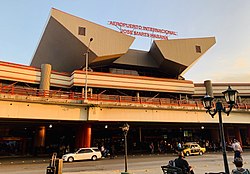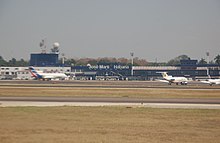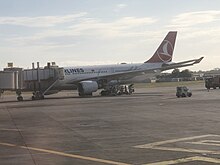José Martí International Airport
José Martí International Airport Rancho Boyeros Airport | |||||||||||
|---|---|---|---|---|---|---|---|---|---|---|---|
 | |||||||||||
| Summary | |||||||||||
| Airport type | Public | ||||||||||
| Operator | ECASA | ||||||||||
| Serves | Havana | ||||||||||
| Location | Boyeros | ||||||||||
| Hub for | |||||||||||
| Built | February 24, 1930[1] | ||||||||||
| Elevation AMSL | 64 m / 210 ft | ||||||||||
| Coordinates | 22°59′21″N 082°24′33″W / 22.98917°N 82.40917°W | ||||||||||
| Website | https://www.havana-airport.org/ | ||||||||||
| Map | |||||||||||
 | |||||||||||
| Runways | |||||||||||
| |||||||||||
| Statistics (2022) | |||||||||||
| |||||||||||
Source: Aerodrome chart[2] | |||||||||||
José Martí International Airport (IATA: HAV, ICAO: MUHA), sometimes known by its former name Rancho Boyeros Airport, is an international airport located in the municipality of Boyeros, 20 kilometres (12 mi) southwest of the centre of Havana, Cuba, and is a hub for Cubana de Aviación and Aerogaviota, and former Latin American hub for the Soviet (later Russian) airline Aeroflot.[5] It is Cuba's main international airport, and serves several million passengers each year. The facility is operated by Empresa Cubana de Aeropuertos y Servicios Aeronáuticos (ECASA).
The airport lies in the municipality of Boyeros and connects Havana with the rest of the Caribbean, North, Central and South America, as well as Europe. It is named in memory of patriot and poet José Martí.
Private Cuban citizens are not allowed to own aircraft; all aircraft in Cuba belong to state-owned airlines or the military. Only government- and foreign-owned aircraft are allowed to use the facilities. As of 2020[update], Copa Airlines was the foreign airline with most flights to the airport, operating 34 flights a week (roughly five daily flights) from Panama City, Panama, and Bogotá, Colombia.
History
[edit]




The current José Martí Airport in 1930 replaced the Columbia Airfield, which was the first airport to serve Havana. The original name of the airport, Rancho Boyeros, meaning the "(Bull) Drover Ranch", was in reference to the name of the plains where the airport was being built. It was known as the Rancho Boyeros because in colonial times a local family had built a thatched hut and provided meals and an inn to the weary drovers that brought agricultural products to the capital from Batabanó and Vuelta Abajo.
To give a progressive environment to the airport, the old ranch homes were transformed into a small town that would serve as an industrial, livestock, agriculture and commercial centre, rising comfortable homes, an industrial technical school, a paint factory and other facilities. The town today is known as the Boyeros Municipality.
Beginnings
[edit]- 1929: The construction of José Martí Airport, formerly Rancho Boyeros Airport, was authorized in March 1929 by General Order No. 223.
- 1930: On February 24, the airport opened, replacing Havana Columbia Airfield.
- 1930: On October 30, the first flight by Cubana de Aviación (formerly Compañía Nacional Cubana de Aviación Curtiss) from Havana to Santiago de Cuba carried the mail on a Ford Trimotor with stops in Santa Clara, Morón and Camagüey.
- 1936: non-commercial flights to Madrid started with a Lockheed Sirius named September 4, commanded by Capt. Antonio Menéndez Pélaez. She was flown via Venezuela, Natal, Brazil, and Dakar, Senegal.
- 1943: By January 1943 the airport had its first control tower, the first in the country.
- 1945: The International Air Transport Association (IATA) is formed at Havana.
- 1945: Cubana's first international flight out of the airport was a Douglas DC-3 to Miami on May 15.
- 1946: First transatlantic flight from any Latin American country to Europe: Havana-Madrid was on DC-4, operated by Aerovias Cubanas Internacionales (Cunnair), founded by Cuban pioneer Reinaldo Ramirez Rosell.
- 1948: On May 5 Cubana's first transatlantic flight Havana-Madrid was on DC-4 Estrella de Cuba.
- 1950: On April 2 the airport had a second route to Europe, Havana-Rome on a Cubana de Aviación DC-4.
- 1951: The first night flight landed at the airport from Santiago de Cuba with a DC-3.
- 1953: First flight to Mexico City on a Cubana Constellation.
International service in the 1950s
[edit]- Pan American World Airways in the 1950s had 4-8 daily flights from Havana to Miami. It connected Havana with Mérida and San Salvador, with DC-4 and DC-6. It also had flights to the south, including Jamaica, Venezuela and other South American countries. [citation needed]
- Aerolíneas Argentinas connected Buenos Aires to Havana via Rio de Janeiro, Trinidad, and New York City, with DC-6s.
- Aeropostal Venezolana S.A. flew Miami-Havana-Caracas with Super Constellations.
- Braniff International Airways DC-6s connected Havana to the north with Houston, and to the south with Panama and other South American countries, such as Ecuador, Peru, Colombia, Argentina and others.
- Delta Air Lines connected Havana with New Orleans and Chicago and to the south with Montego Bay, Jamaica and Caracas. It also flew from Havana to Port-au-Prince, Haiti, Santo Domingo, Dominican Republic, and San Juan, Puerto Rico. It flew with Convair 440 and DC-7. Delta resumed its flights to New Orleans in March 2015, after not flying the route for over 50 years.[6]
- Iberia vied with Cubana in the route to Madrid, with Super Constellations.
- KLM flew between Havana-Montreal-Europe with DC-7 and the route Miami-Havana-Curaçao, with DC-6 and DC-7.
- LACSA, Líneas Aéreas Costarricenses, connected Havana with San José and other cities in Central America, such as Guatemala City, mainly with Convair 340.
- Mackey Airlines inaugurated its passenger service between Fort Lauderdale and Havana, with DC-4.
- Mexicana de Aviación flew between Havana, Mérida and Mexico City, 4 times weekly.
- National Airlines in 1958 flew daily from New York City, Tampa, and Miami, with DC-6, DC-7 and Convair 340/440.
- Cubana de Aviación in 1958 flew five daily Viscount 818s to Miami, and Bristol Britannia 318s to Madrid, Mexico City, and New York. [citation needed]
Recent history
[edit]In 1961, diplomatic relations with the United States deteriorated substantially and with the United States embargo against Cuba, airlines from the United States were not permitted to operate regular scheduled flights to the airport. That year, two days prior to the failed Bay of Pigs Invasion organized by the CIA with the participation of Cuban exiles, Douglas A-26 Invader aircraft from Brigade 2506 bombarded José Martí Airport and Antonio Maceo Airport in Santiago de Cuba.
Because of Cuba's relationship with the Soviet Union, the airport during the 1970s and 1980s enjoyed the presence of many Eastern Bloc airline companies, such as Aeroflot, Czechoslovak Airlines, Interflug, and LOT Polish Airlines. In 1977 an Aeroflot Ilyushin Il-62 operating a scheduled flight from Moscow to Havana via Frankfurt and Lisbon crashed after takeoff from Lisbon, killing 68 of the 70 on board and one person on the ground.[7] In 1989 another Ilyushin Il-62, operated by Cubana as Cubana de Aviación Flight 9046, crashed shortly after takeoff from Havana. All 115 passengers and 11 crew members as well as a number persons on the ground were killed.
In 1988, Terminal 2 was constructed in anticipation of future charter flights to the United States. In the 1990s the special charter flights were approved by the US government, to operate from Miami for Cuban citizens living in the United States that have close relatives in Cuba. Today, various airlines operate non-stop scheduled charter service between Havana and Miami. Terminal 2 was remodeled and expanded in 2010.
On December 31, 1997 a Concorde landed in Cuba for the first time, landing at José Martí Airport.[8] The London-Paris-Barbados-Havana Air France flight was received at the airport by Fidel Castro, who boarded the aircraft and greeted the crew and passengers. On April 26 the following year, the new International Terminal 3 was inaugurated by Canada's Prime Minister Jean Chrétien and Cuba's President Fidel Castro. In 2002 Air Freight Logistics Enterprise (ELCA S.A.) opened José Martí's first freight terminal known as the Aerovaradero Freight Terminal. The terminal has a 600 t (590 long tons; 660 short tons) capacity, 2,000 m3 (71,000 cu ft) of space in two refrigeration and freezing chambers, with humidity and gas controls.
In 2007, three young recruits who deserted from the Cuban Army tried to hijack a commercial passenger aircraft aiming to defect to the United States. At Terminal 1, the would-be hijackers killed one of the hostages, a lieutenant colonel.[9]
Special charter service to the United States were allowed from the 1990s, but were required to be operated by travel companies licensed by the U.S. government, largely from Florida. In March 2015, Sun Country Airlines started operating regularly scheduled charter flights from New York during the Cuban Thaw.[10] Regularly scheduled commercial service to and from the United States began again in the fall of 2016, with such airlines as American, Delta, JetBlue and, after January 2017, Alaska, flying to Havana.[11] However, several airlines had dropped, if not cut back, flights to Cuba by late 2017 due in part to President Trump's decision to reimpose stricter travel regulations, therefore partially ending the Cuban Thaw. Several other reasons that the airlines ended the flights were because of weaker-than-expected demand and a paucity of tourist infrastructure.[12]
In February 2016, a VIP room at the airport was used as the location for the historic meeting of Pope Francis and Patriarch Kirill.
In March 2020, Cuba announced that it was closing its borders because of the COVID-19 pandemic. Only humanitarian flights were then permitted. On November 10, 2020, it was announced that the airport would re-open to commercial flights on November 15.[13] Some airlines started operations again, but not all those which had flown previously. In January 2021, the Cuban authorities placed restrictions on the number of flights from a number of countries, and halted flights from a few. Separately, Canadian airlines stopped flying to Caribbean destinations, including Cuba.
Terminals
[edit]

There are currently three passenger terminals in general use at the airport.[14] Terminal 1 is used primarily for domestic flights. Terminal 2 opened in 1988, primarily for charter flights to the United States. Ten years later on April 27, 1998, the International Terminal 3 opened, offering many modern facilities and jetways that the former international Terminal 1 did not provide. For transfer between terminals, bus services are offered.[citation needed]
Terminal 1
[edit]Domestic Terminal 1 was the main international and domestic terminal building in the airport prior to the opening of Terminals 2 and 3. It is located on the east side of Runway 6, and is now used primarily for domestic flights.
Terminal 2
[edit]Terminal 2 handles some long-distance international flights, such as to Zürich, Frankfurt, and Helsinki, along with a few Caribbean flights, such as to Aruba, Trinidad and Tobago, and most scheduled charter flights to and from Miami, Tampa, Ft. Lauderdale, and New York City. The scheduled charter flights to the United States are operated by Gulfstream Air Charters, ABC Charters, Marazul Charters, CTS Charters, and C & T Charters. The terminal is located on the north side roughly 2 kilometres (1.2 mi) from Terminal 3, and is just in front of the threshold of runway 24. It was constructed in 1988 when the first charter flights after the revolution were opened from Miami. There are bars, bookshops, newsagents, a restaurant, and car rentals.
Terminal 3
[edit]International Terminal 3 is the main international terminal, opened in 1998. It is the largest and most modern of all terminals. Ticketing and departures are located on the upper level; arrivals and baggage carousels are located on the lower level. There are several car rentals located in the arrivals area.
Airlines and destinations
[edit]The following airlines operate regular scheduled and charter flights at Havana Airport:
Accidents and incidents
[edit]- On August 9, 1961, shortly after takeoff, five hijackers stormed the cockpit of a Cubana de Aviación Curtiss C-46 Commando in which the captain was killed as well as a hijacker and a guard. The co-pilot attempted to go back to Havana Airport and made an emergency landing in a sugar cane field, four hijackers fled the scene. Three died during the hijacking, all others survived the emergency landing.[21]
- On May 14, 1973, Cubana de Aviación Flight CU 707, an Antonov An-24, crashed in bad weather on landing at Havana Airport because of pilot error and miscommunication by the co-pilot. Three occupants died, four were seriously injured and another ten had minor injuries.[22]
- A 1977 Aeroflot Ilyushin 62 crash on May 27 killed 68 of the 70 on-board and one person on the ground. At the time, the accident was the deadliest aviation accident in Cuba's history; it remains the third deadliest. One of the victims was José Carlos Schwarz, a poet and musician from Guinea-Bissau.
- On July 7, 1983, Air Florida Flight 8 with 47 people on board was flying from Fort Lauderdale International Airport to Tampa International Airport. One of the passengers handed a note to one of the flight attendants, saying that he had a bomb and telling them to fly the plane to Havana, Cuba. He revealed a small athletic bag, which he opened and inside was an apparent explosive device. The airplane was diverted to Havana-José Martí International Airport and the hijacker was taken into custody by Cuban authorities.[23]
- On September 3, 1989, Cubana de Aviación Flight 9046, an Ilyushin Il-62M (CU-T1281) operating a non-scheduled international passenger flight to Cologne (Cologne Bonn Airport), West Germany, crashed shortly after take-off. All 115 passengers and 11 crew members as well as 24 persons on the ground were killed and the aircraft was written off.
- On May 3, 2007, two army recruits hijacked a plane destined for Miami at José Martí International Airport in Havana. The men killed a hostage before being arrested prior to takeoff. It was the first Cuban hijacking attempt reported since the spring of 2003.[24]
- On May 18, 2018, a Global Air (Mexico) Boeing 737-200 operating as Cubana de Aviación Flight 972 crashed after takeoff, killing 112 of the 113 people on board (107 passengers and 6 crew).[25]
- On March 5, 2023, a Southwest Airlines Boeing 737 MAX 8 bound for Fort Lauderdale returned for an emergency landing after a bird strike resulted in damage to one of its engines and made smoke fill the cabin.[26]
See also
[edit]References
[edit]![]() This article incorporates public domain material from the Air Force Historical Research Agency
This article incorporates public domain material from the Air Force Historical Research Agency
- ^ "90 aniversario del Aeropuerto". February 25, 2020.
- ^ "Jose Marti Airport diagram" (PDF). iacc.gov.cu (in Spanish). May 10, 2007. Archived from the original (PDF) on March 22, 2012. Retrieved August 24, 2011.
- ^ "Top 20 fastest-growing major airports in the world". Routesonline.com. March 16, 2018. Archived from the original on March 27, 2018. Retrieved March 26, 2018.
- ^ "Havana Jose Marti International Airport: Exciting times and the opportunity to become a regional hub". Archived from the original on November 8, 2016. Retrieved November 7, 2016.
- ^ "COMPANY NEWS - Aeroflot May Shift A Hub to Miami - NYTimes.com". New York Times. October 4, 1990.
- ^ "First Direct Flight From New Orleans To Cuba Since 1958 To Take Off This Weekend". The Huffington Post. March 13, 2015. Archived from the original on April 2, 2015. Retrieved June 4, 2015.
- ^ Ranter, Harro. "ASN Aircraft accident Ilyushin Il-62M CCCP-86614 Havana-José Martí International Airport (HAV)". aviation-safety.net. Retrieved January 3, 2020.
- ^ "VIDEO: El día que el Concorde aterrizó en La Habana, Cuba". CiberCuba (in Spanish). April 8, 2017. Retrieved September 11, 2019.
- ^ "Frustrated attempt to hijack a commercial passenger plane". ipsnews.net. Archived from the original on July 1, 2011. Retrieved July 25, 2011.
- ^ ABC News. "U.S. News - National News". ABC News. Archived from the original on March 26, 2015. Retrieved April 3, 2015.
- ^ "U.S. clears 6 airlines for takeoff to Cuba, but flights won't start right away". Miami Herald. Archived from the original on July 23, 2016. Retrieved July 19, 2016.
- ^ Josephs, Leslie (November 8, 2017). "Another U.S. airline is quitting Cuba". CNBC.
- ^ "Aeropuerto Internacional José Martí reiniciará operaciones el próximo 15 de noviembre". November 11, 2020.
- ^ "Aerodromos de Cuba". iacc.gov.cu (in Spanish). Archived from the original on April 4, 2012.
- ^ "Russian company will soon restore flights to Havana". Cuba Si. October 5, 2024. Retrieved October 6, 2024.
- ^ a b "Air China will start direct Beijing-Havana flights in May". Prensa Latina. April 12, 2024. Retrieved April 13, 2024.
- ^ https://aviacionline.com/2024/10/avianca-opens-sales-for-new-bogota-havana-route-set-to-launch-in-december/
- ^ a b "Conviasa Extends Havana – Moscow Service into 2024". AeroRoutes. August 29, 2023. Retrieved August 30, 2023.
- ^ "Plus Ultra Adds Madrid – Havana Scheduled Charters in 3Q24". Aeroroutes. Retrieved April 10, 2024.
- ^ "Sky High Dominicana to introduce non-stop flights from Cuba to Guyana from May 27". May 18, 2024.
- ^ Accident description for unknown at the Aviation Safety Network. Retrieved on October 6, 2023.
- ^ Accident description for CU-T876 at the Aviation Safety Network. Retrieved on October 6, 2023.
- ^ Harro Ranter (July 7, 1983). "ASN Aircraft accident Boeing 737 registration unknown Havana-José Martí International Airport (HAV)". Archived from the original on May 7, 2015. Retrieved June 4, 2015.
- ^ (in English) Americas: Cuba: Officer Dies In Plane Hijacking Attempt Archived June 1, 2016, at the Wayback Machine, The New York Times, May 4, 2007.
- ^ "More than 100 die in Cuba plane crash". BBC News. May 18, 2018. Archived from the original on August 11, 2018. Retrieved May 18, 2018.
- ^ Bugante, Kristina; Rodriguez, Laura (March 5, 2023). "Video Shows Scary Moments After Bird Strike Leads to Southwest Cabin Filling With Smoke". NBC 6 South Florida. Retrieved August 14, 2024.
External links
[edit]![]() Media related to José Martí International Airport at Wikimedia Commons
Media related to José Martí International Airport at Wikimedia Commons

